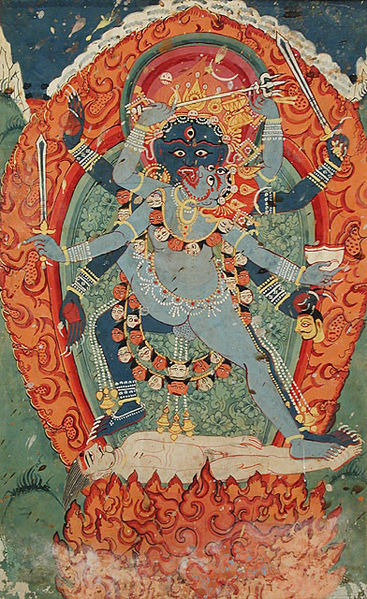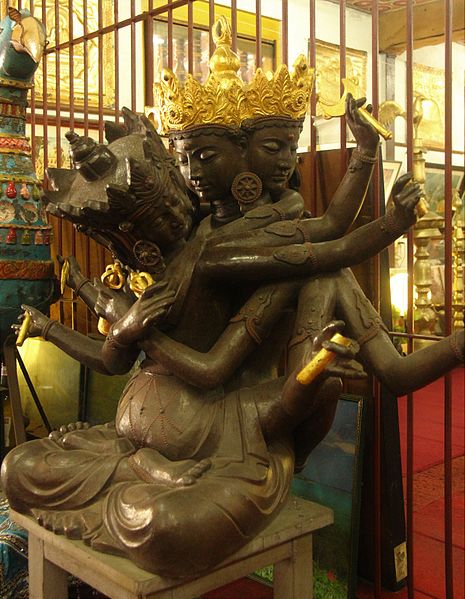Yab - Yum
Yab-Yum(tibet. Father-Mother) is a iconographic representation of the union of a male and a female deity, especially known from Tantric Buddhism. But the many ritual objects in the hands of the partners should be noted.
Many of these representations hide a secret symbolism of the rearward male and the front female energy - circuits of the front chakras and hide simultaneously some ritual techniques, similar to the alchemistic Rosarium Philosophorum and the taoist 'Circles of Light' of Neidan Qigong.

Hinduism
In Hindu tantra, the Yab-Yum has a slightly different meaning. The position represents the divine power of creation and the force of creation. The passive-static male deity (divine consciousness) in Hinduism embraces his companion, called Shakti, who represents his activity or power.
The tantric Maithuna ritual with the 5 Ms belongs to the left path of tantra (vamacara). It is actually not practiced at all by viryas and real initiates, as orgastic pleasure is rather ridiculous to spiritual Ananda, and the high initiate does not have to transform any subterranean powers.
Such ritual texts have also a very different deeper meaning, such as for example the Kulanarva Tantra has.
Tantric Buddhism
In tantric Buddhism, this iconography is by default interpreted as a primordial union of active compassion and means (karuṇā and upāya-kauśalya) and passive wisdom (wisdom, wisdom dakini, etc.), sometimes as a unity of consciousness and emptiness or unity of appearances and emptiness, or also of method and wisdom in union. A small contradiction arises with the Wisdom Consort of a Wisdom Buddha.
The symbolism of the individual thangkas contains however much more secret in detail. In the advanced yoga methods of the Vajrayana, the energy winds (development, relaxation, Skt. Prana) are brought into the central energy channel. With regard to the two energy cycles, it is therefore of particular importance whether the couple is standing in front of each other or sitting devoured.
Rarely is a Kamamudra practiced, which is only approved for advanced aspirants and is based at least on the tummo of the 6 exercises of Naropa.

Karmamudrā (Sanskrit, "action seal," also erroneously: kamamudrā or "lust seal," Tib. Las-kyi phyag-rgya) is rarely practiced sexual practice of Vajrayana with a physically present or visualized consorts. The latter is then called jnanamudra.
The union in hindu tantra is not wholly comparable to the Buddhist form, and thus Maheshvara-Maheshvari are only identical in synthesis to Samantabhadra-Samantabhadri.
Literature
- The Marriage of Wisdom and Method PDF
- Short Hayagriva-Yab-Yum(Gadenforthewest)
- The Wheel of Time: The Kalachakra in Context, Geshe Lhundub Sopa, S. 30
- Dakini's Warm Breath: The Feminine Principle in Tibetan Buddhism, Judith Simmer-Brown, Shambhala Publications,
See also :
- Panchamakaras
- Kaula Achara - 5ms
References
- ↑ www.tantra-blog.de/tantra-maithuna-ritual Maithuna-Ritual
Weblinks
- Wiki about Yab-Yum
- Tantric Metaphorik
of Spirituality
universal-path.org